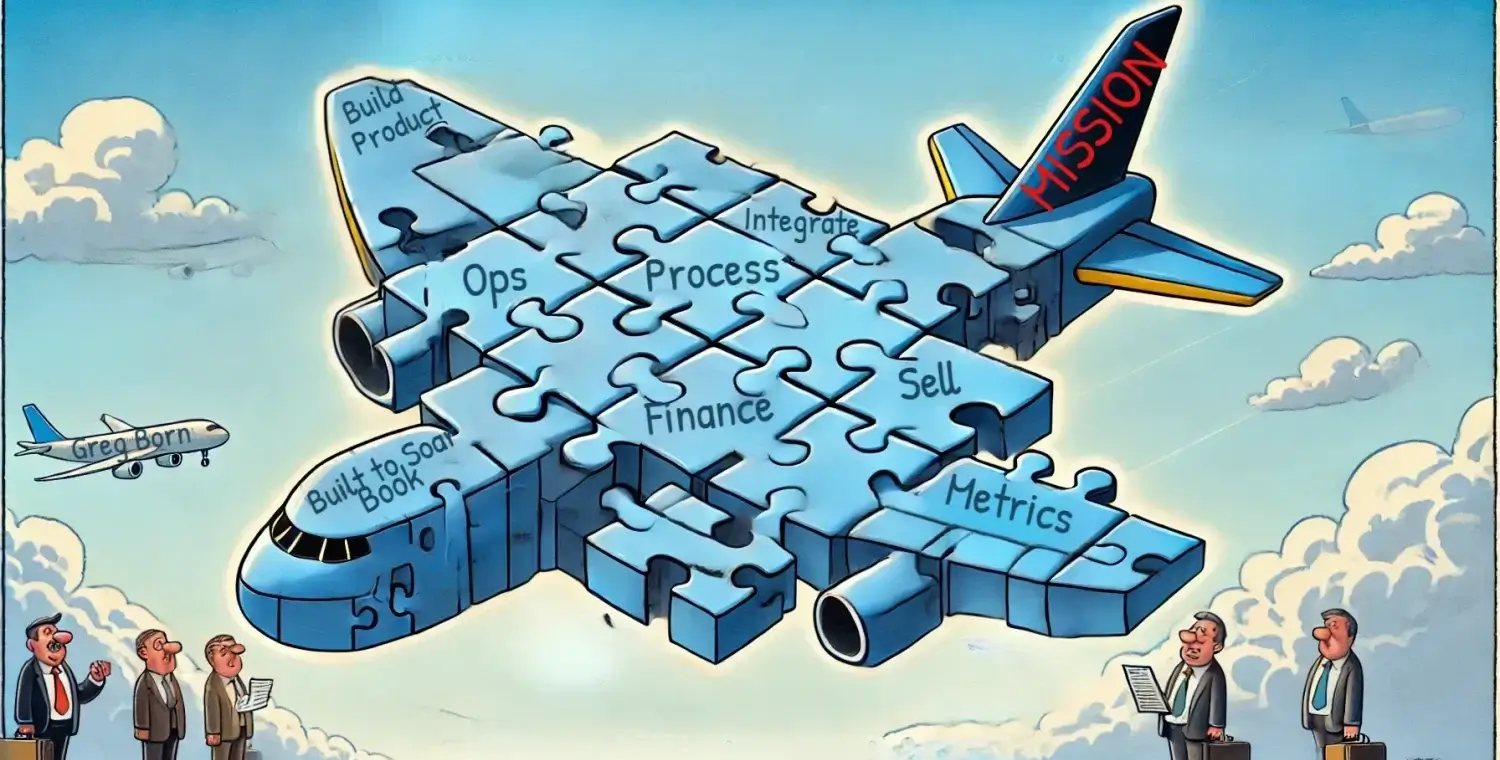My CFO just resigned. He had just gotten a great offer and a lot of equity to move to a startup.
Soon after that, one of my board members reached out asking when I was going to hire a replacement. I told him I wasn’t.
“What? You’re not going to hire a replacement CFO???” he exclaimed. As I looked to grow the business, what we really needed were the competencies and skills to address our actual business needs. I had an accounting team in place and an FP&A person to pull everything together. What I didn’t need was an extra layer of hierarchy. My answer was simple: I don’t need a CFO.
This unexpected moment brought up a deeper question: in a purpose-built business, every role and every process exists for a reason. They are all aligned toward one objective – to grow the business. Here’s how I think about that, and why restructuring around purpose rather than titles can drive unprecedented results. I discuss this deeper in the Built To Soar Book.
Beyond the Title: Recognizing Real Value
Traditional hierarchies often lead us to equate prestige with talent. The board member’s reaction was typical — if someone with a fancy title leaves, the system assumes their absence creates a void needing an equally glittering replacement. But let’s be honest: when you strip away the labels, it’s the competencies and incremental improvements that matter. Titles are merely words. What truly fuels exponential growth is the ability to add value through tangible expertise.
Over the years, I’ve learned that the skills required to manage our numbers, generate insights, and adapt to change aren’t necessarily embodied in a top executive title. The right mix of an experienced accounting team with a dedicated FP&A professional provides the same, if not higher, value than a single person who holds a prestigious title. By focusing on the actual functions that drive outcomes, you open up space for innovative approaches and greater accountability across the organization.
So, the next time you’re presented with a traditional
expectation in business,
ask yourself,
Are you building a business of functions,
or are you forging a purpose-driven machine
that thrives on real competencies?
Streamlining for Success: Aligning Roles with Mission
When building a purpose-driven organization, every role has a precise impact on the business’s growth. It isn’t about accumulating lofty titles; it’s about aligning skills and processes with the company’s mission. When I decided not to hire a replacement CFO, I wasn’t ignoring the importance of financial oversight—I was deliberately aligning our human resources with our strategic priorities.
In our case, the mission was clear: grow the business by using our core competencies. Our accounting team, versed in the minutiae of numbers, was finely tuned to handle complex financial operations. Meanwhile, our FP&A professional synthesized these numbers into actionable insights. Rather than layering the organization with unnecessary titles, each role was streamlined to serve a well-defined purpose. This agile structure not only reduces redundancy but also reinforces the idea that every resource is deployed with intention.
When teams understand that every role exists to support a singular mission, they become more empowered and accountable. They focus on outcomes rather than stepping on toes just to climb the corporate ladder. The result is a culture where every day’s work is directly linked to advancing the company’s strategic objectives.
Building a Culture of Accountability and Adaptability
The real magic happens when an organization embeds its purpose into every level of operations. A purpose-driven culture isn’t built overnight. It requires discipline, continuous refinement, and a steadfast commitment to aligning actions with organizational goals.
In our streamlined model, decisions are made based on measurable outcomes rather than hierarchical position. For instance, instead of appointing a CFO based solely on title expectation, we use performance metrics and competency-based evaluations. This shift from traditional role-based decision-making to competency-based operations fosters an environment in which accountability is the norm. Employees appreciate clear expectations: they know what success looks like and understand their direct impact on achieving it.
Moreover, when each team member is selected and trained for their specific contribution, there is less room for ambiguity. Processes are developed to reinforce behaviors that support growth. Regular reviews and feedback loops replace the old routine of annual performance evaluations. Instead of simply recognizing lofty ideals, the focus is on sustaining behaviors that directly contribute to the organization’s mission—making improvements that are both strategic and measurable.

Harnessing Purpose to Spur Innovation and Growth
With a purpose-built organization, the energy spent on defending titles and outdated hierarchies is minimized. Instead, that energy is redirected toward innovation, efficiency, and explosive growth. A clear mission serves as the north star in every decision, from product development to customer engagement strategies.
Think back to the moment I explained to the board member why we weren’t hiring a replacement CFO. That conversation wasn’t just about saving a salary line—it was about redirecting our focus to strategic priorities. Our decision freed us to invest in capabilities that generate real value. We allocated resources to advanced accounting software and to training our existing team, ensuring that we remained lean and agile.
When every process and role is purposefully designed, the organization is better prepared to adapt to market changes. Instead of being box-checked by tradition, our structure promotes continuous learning and responsiveness. The result is a business model in which growth is not a matter of chance, but a reflection of well-orchestrated behavior and a commitment to excellence.
Embracing the Future: Agility Over Authority
In today’s rapidly evolving marketplace, agility often trumps authority. When organizations cling to outdated titles, they risk anchoring themselves in bureaucracy. A purpose-driven organization, however, continuously reexamines its internal processes and adjusts roles to meet emerging priorities. This dynamic approach ensures that every employee is not only aware of the company’s mission but is actively contributing to it.
Rather than hiring outside replacements to fill perceived gaps, we invest in our current team’s growth. Development programs, cross-training initiatives, and collaborative projects become the norm. This way, every team member grows in line with the company’s evolving needs, creating a robust leadership pipeline that’s grounded in shared purpose.
The moral here is clear: leadership today is not defined by a title on a nameplate but by the consistent ability to steer the business with clarity and conviction. When every decision is guided by a purpose—to innovate, simplify, and grow—the business becomes resilient and more competitive. Employees become leaders in their own right, carrying forward the legacy of a purpose-driven culture.
The Power of Purpose-Driven Alignment
My decision not to hire a replacement CFO sparked a fundamental rethinking of our business model. It revealed that when every role, process, and decision is purposefully designed, the organization thrives on the strength of its competencies, not its titles. A purpose-driven organization is one where every element is carefully aligned toward a single objective: sustainable growth.
By scrutinizing and streamlining our roles, embedding accountability into everyday actions, and investing in continuous improvement, we established an environment where every team member has a clear, measurable impact. The transformation allowed us to free up resources, empower our employees, and ultimately drive innovation more effectively.
In today’s competitive landscape, where change is the only constant, organizations must look beyond traditional titles and rigid hierarchies. They must ask themselves whether they are truly structured for success—or if they’re simply holding on to obsolete models. When purpose becomes the foundation upon which every decision is made, growth is not only achievable—it becomes inevitable.
So, the next time you’re presented with a traditional expectation, ask yourself: Are you building a business of functions, or are you forging a purpose-driven machine that thrives on real competencies and behaviors? The difference between holding a title and harnessing talent is profound—and it can be the key to soaring above the competition.


